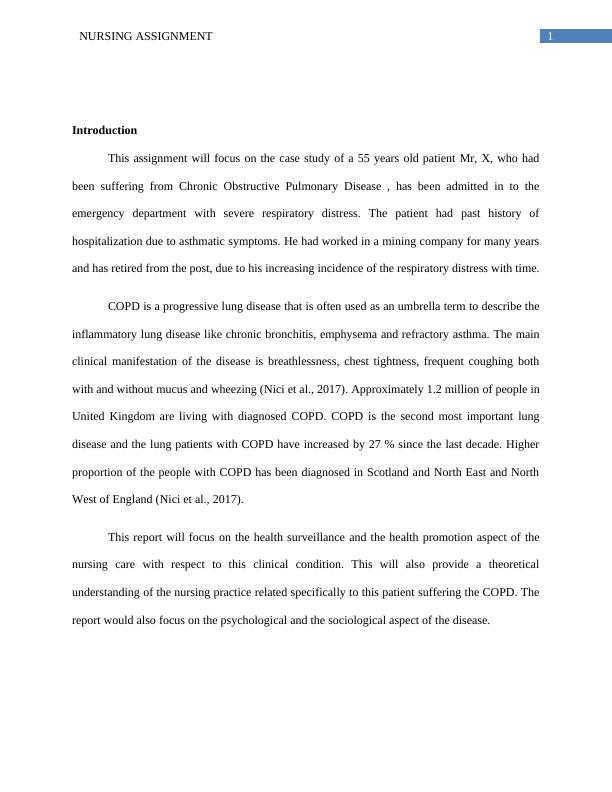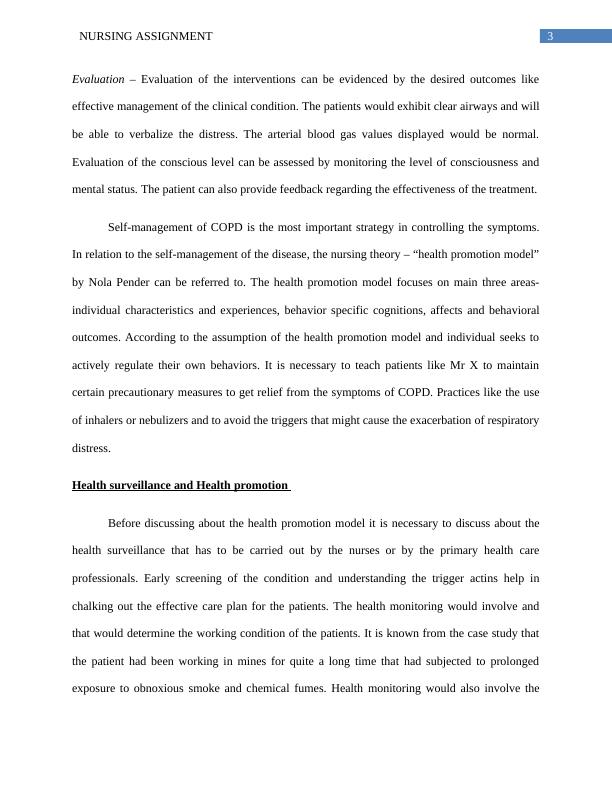Nursing Assignment: COPD Case Study
Added on 2023-03-31
11 Pages2424 Words126 Views
Running head: NURSING ASSIGNMENT
NURSING ASSIGNMENT
Name of the Student
Name of the university
Author’s note
NURSING ASSIGNMENT
Name of the Student
Name of the university
Author’s note

1NURSING ASSIGNMENT
Introduction
This assignment will focus on the case study of a 55 years old patient Mr, X, who had
been suffering from Chronic Obstructive Pulmonary Disease , has been admitted in to the
emergency department with severe respiratory distress. The patient had past history of
hospitalization due to asthmatic symptoms. He had worked in a mining company for many years
and has retired from the post, due to his increasing incidence of the respiratory distress with time.
COPD is a progressive lung disease that is often used as an umbrella term to describe the
inflammatory lung disease like chronic bronchitis, emphysema and refractory asthma. The main
clinical manifestation of the disease is breathlessness, chest tightness, frequent coughing both
with and without mucus and wheezing (Nici et al., 2017). Approximately 1.2 million of people in
United Kingdom are living with diagnosed COPD. COPD is the second most important lung
disease and the lung patients with COPD have increased by 27 % since the last decade. Higher
proportion of the people with COPD has been diagnosed in Scotland and North East and North
West of England (Nici et al., 2017).
This report will focus on the health surveillance and the health promotion aspect of the
nursing care with respect to this clinical condition. This will also provide a theoretical
understanding of the nursing practice related specifically to this patient suffering the COPD. The
report would also focus on the psychological and the sociological aspect of the disease.
Introduction
This assignment will focus on the case study of a 55 years old patient Mr, X, who had
been suffering from Chronic Obstructive Pulmonary Disease , has been admitted in to the
emergency department with severe respiratory distress. The patient had past history of
hospitalization due to asthmatic symptoms. He had worked in a mining company for many years
and has retired from the post, due to his increasing incidence of the respiratory distress with time.
COPD is a progressive lung disease that is often used as an umbrella term to describe the
inflammatory lung disease like chronic bronchitis, emphysema and refractory asthma. The main
clinical manifestation of the disease is breathlessness, chest tightness, frequent coughing both
with and without mucus and wheezing (Nici et al., 2017). Approximately 1.2 million of people in
United Kingdom are living with diagnosed COPD. COPD is the second most important lung
disease and the lung patients with COPD have increased by 27 % since the last decade. Higher
proportion of the people with COPD has been diagnosed in Scotland and North East and North
West of England (Nici et al., 2017).
This report will focus on the health surveillance and the health promotion aspect of the
nursing care with respect to this clinical condition. This will also provide a theoretical
understanding of the nursing practice related specifically to this patient suffering the COPD. The
report would also focus on the psychological and the sociological aspect of the disease.

2NURSING ASSIGNMENT
Nursing practice
The nursing practice related to the management of the interventions includes Assessment,
planning, Implementation and evaluation.
Assessment- NICE has recommended curtained guidelines for assessing the signs and symptoms
of COPD. The patients should be assessed for the signs and the symptoms like an increased
respiratory rate, especially whether the patient is using accessory muscles or not or the presence
of pursed lip breathing, state of the acute confusion, that can be related to conditions like
hypoxia. The patient should also be assessed for new onset cyanosis or the presence of peripheral
edema that might indicate new onset or pulmonale or if the patient is unable to carry out the
activities of daily living.
Planning – The nurses should aim to maintain the airway patency with clear breath sound or
assist the patients to cough effectively and expectorate the secretions. The nurses should aim to
an improved ventilation and adequate oxygenation of the tissue by ABGs within the normal
range of the patient (Fletcher & Dahl, 2013). The patient will be able to participate in the
treatment regimen. The nurses would plan to improve the breathing pattern in the patient and the
respiratory limit would be maintained within normal limits.
Implementation- For improving the breathing the pattern in patient, the patient should be place in
patient in semi –fowler’s position for promoting maximum expansion of the lungs. Patients back
should be kept dry to avoid the stasis of secretions and to prevent further complications. For
maintaining the patent airway, the suctioning of the secretions might be done as ordered. Nurses
can also administer he prescribed cough suppressant and analgesics.
Nursing practice
The nursing practice related to the management of the interventions includes Assessment,
planning, Implementation and evaluation.
Assessment- NICE has recommended curtained guidelines for assessing the signs and symptoms
of COPD. The patients should be assessed for the signs and the symptoms like an increased
respiratory rate, especially whether the patient is using accessory muscles or not or the presence
of pursed lip breathing, state of the acute confusion, that can be related to conditions like
hypoxia. The patient should also be assessed for new onset cyanosis or the presence of peripheral
edema that might indicate new onset or pulmonale or if the patient is unable to carry out the
activities of daily living.
Planning – The nurses should aim to maintain the airway patency with clear breath sound or
assist the patients to cough effectively and expectorate the secretions. The nurses should aim to
an improved ventilation and adequate oxygenation of the tissue by ABGs within the normal
range of the patient (Fletcher & Dahl, 2013). The patient will be able to participate in the
treatment regimen. The nurses would plan to improve the breathing pattern in the patient and the
respiratory limit would be maintained within normal limits.
Implementation- For improving the breathing the pattern in patient, the patient should be place in
patient in semi –fowler’s position for promoting maximum expansion of the lungs. Patients back
should be kept dry to avoid the stasis of secretions and to prevent further complications. For
maintaining the patent airway, the suctioning of the secretions might be done as ordered. Nurses
can also administer he prescribed cough suppressant and analgesics.

3NURSING ASSIGNMENT
Evaluation – Evaluation of the interventions can be evidenced by the desired outcomes like
effective management of the clinical condition. The patients would exhibit clear airways and will
be able to verbalize the distress. The arterial blood gas values displayed would be normal.
Evaluation of the conscious level can be assessed by monitoring the level of consciousness and
mental status. The patient can also provide feedback regarding the effectiveness of the treatment.
Self-management of COPD is the most important strategy in controlling the symptoms.
In relation to the self-management of the disease, the nursing theory – “health promotion model”
by Nola Pender can be referred to. The health promotion model focuses on main three areas-
individual characteristics and experiences, behavior specific cognitions, affects and behavioral
outcomes. According to the assumption of the health promotion model and individual seeks to
actively regulate their own behaviors. It is necessary to teach patients like Mr X to maintain
certain precautionary measures to get relief from the symptoms of COPD. Practices like the use
of inhalers or nebulizers and to avoid the triggers that might cause the exacerbation of respiratory
distress.
Health surveillance and Health promotion
Before discussing about the health promotion model it is necessary to discuss about the
health surveillance that has to be carried out by the nurses or by the primary health care
professionals. Early screening of the condition and understanding the trigger actins help in
chalking out the effective care plan for the patients. The health monitoring would involve and
that would determine the working condition of the patients. It is known from the case study that
the patient had been working in mines for quite a long time that had subjected to prolonged
exposure to obnoxious smoke and chemical fumes. Health monitoring would also involve the
Evaluation – Evaluation of the interventions can be evidenced by the desired outcomes like
effective management of the clinical condition. The patients would exhibit clear airways and will
be able to verbalize the distress. The arterial blood gas values displayed would be normal.
Evaluation of the conscious level can be assessed by monitoring the level of consciousness and
mental status. The patient can also provide feedback regarding the effectiveness of the treatment.
Self-management of COPD is the most important strategy in controlling the symptoms.
In relation to the self-management of the disease, the nursing theory – “health promotion model”
by Nola Pender can be referred to. The health promotion model focuses on main three areas-
individual characteristics and experiences, behavior specific cognitions, affects and behavioral
outcomes. According to the assumption of the health promotion model and individual seeks to
actively regulate their own behaviors. It is necessary to teach patients like Mr X to maintain
certain precautionary measures to get relief from the symptoms of COPD. Practices like the use
of inhalers or nebulizers and to avoid the triggers that might cause the exacerbation of respiratory
distress.
Health surveillance and Health promotion
Before discussing about the health promotion model it is necessary to discuss about the
health surveillance that has to be carried out by the nurses or by the primary health care
professionals. Early screening of the condition and understanding the trigger actins help in
chalking out the effective care plan for the patients. The health monitoring would involve and
that would determine the working condition of the patients. It is known from the case study that
the patient had been working in mines for quite a long time that had subjected to prolonged
exposure to obnoxious smoke and chemical fumes. Health monitoring would also involve the

End of preview
Want to access all the pages? Upload your documents or become a member.
Related Documents
Development of a Person-centred Care Plan Assignment 2022lg...
|14
|3599
|24
Pathophysiology and Pharmacology of Asthma: Case Studylg...
|13
|3903
|80
Managing Chronic Obstructive Pulmonary Disease (COPD): A Case Studylg...
|11
|3361
|107
Nursing Assessment of Breathing: Importance, Techniques, and COPD Managementlg...
|14
|3197
|292
Nursing Care plan Of A Patientlg...
|11
|2910
|22
Jim Copper’s Health Issue Case Study.lg...
|11
|2847
|1